Xumin Yu
Vision Generalist Model: A Survey
Jun 11, 2025Abstract:Recently, we have witnessed the great success of the generalist model in natural language processing. The generalist model is a general framework trained with massive data and is able to process various downstream tasks simultaneously. Encouraged by their impressive performance, an increasing number of researchers are venturing into the realm of applying these models to computer vision tasks. However, the inputs and outputs of vision tasks are more diverse, and it is difficult to summarize them as a unified representation. In this paper, we provide a comprehensive overview of the vision generalist models, delving into their characteristics and capabilities within the field. First, we review the background, including the datasets, tasks, and benchmarks. Then, we dig into the design of frameworks that have been proposed in existing research, while also introducing the techniques employed to enhance their performance. To better help the researchers comprehend the area, we take a brief excursion into related domains, shedding light on their interconnections and potential synergies. To conclude, we provide some real-world application scenarios, undertake a thorough examination of the persistent challenges, and offer insights into possible directions for future research endeavors.
XMask3D: Cross-modal Mask Reasoning for Open Vocabulary 3D Semantic Segmentation
Nov 20, 2024



Abstract:Existing methodologies in open vocabulary 3D semantic segmentation primarily concentrate on establishing a unified feature space encompassing 3D, 2D, and textual modalities. Nevertheless, traditional techniques such as global feature alignment or vision-language model distillation tend to impose only approximate correspondence, struggling notably with delineating fine-grained segmentation boundaries. To address this gap, we propose a more meticulous mask-level alignment between 3D features and the 2D-text embedding space through a cross-modal mask reasoning framework, XMask3D. In our approach, we developed a mask generator based on the denoising UNet from a pre-trained diffusion model, leveraging its capability for precise textual control over dense pixel representations and enhancing the open-world adaptability of the generated masks. We further integrate 3D global features as implicit conditions into the pre-trained 2D denoising UNet, enabling the generation of segmentation masks with additional 3D geometry awareness. Subsequently, the generated 2D masks are employed to align mask-level 3D representations with the vision-language feature space, thereby augmenting the open vocabulary capability of 3D geometry embeddings. Finally, we fuse complementary 2D and 3D mask features, resulting in competitive performance across multiple benchmarks for 3D open vocabulary semantic segmentation. Code is available at https://github.com/wangzy22/XMask3D.
FlowTurbo: Towards Real-time Flow-Based Image Generation with Velocity Refiner
Sep 26, 2024Abstract:Building on the success of diffusion models in visual generation, flow-based models reemerge as another prominent family of generative models that have achieved competitive or better performance in terms of both visual quality and inference speed. By learning the velocity field through flow-matching, flow-based models tend to produce a straighter sampling trajectory, which is advantageous during the sampling process. However, unlike diffusion models for which fast samplers are well-developed, efficient sampling of flow-based generative models has been rarely explored. In this paper, we propose a framework called FlowTurbo to accelerate the sampling of flow-based models while still enhancing the sampling quality. Our primary observation is that the velocity predictor's outputs in the flow-based models will become stable during the sampling, enabling the estimation of velocity via a lightweight velocity refiner. Additionally, we introduce several techniques including a pseudo corrector and sample-aware compilation to further reduce inference time. Since FlowTurbo does not change the multi-step sampling paradigm, it can be effectively applied for various tasks such as image editing, inpainting, etc. By integrating FlowTurbo into different flow-based models, we obtain an acceleration ratio of 53.1%$\sim$58.3% on class-conditional generation and 29.8%$\sim$38.5% on text-to-image generation. Notably, FlowTurbo reaches an FID of 2.12 on ImageNet with 100 (ms / img) and FID of 3.93 with 38 (ms / img), achieving the real-time image generation and establishing the new state-of-the-art. Code is available at https://github.com/shiml20/FlowTurbo.
OpenVoice: Versatile Instant Voice Cloning
Dec 03, 2023Abstract:We introduce OpenVoice, a versatile voice cloning approach that requires only a short audio clip from the reference speaker to replicate their voice and generate speech in multiple languages. OpenVoice represents a significant advancement in addressing the following open challenges in the field: 1) Flexible Voice Style Control. OpenVoice enables granular control over voice styles, including emotion, accent, rhythm, pauses, and intonation, in addition to replicating the tone color of the reference speaker. The voice styles are not directly copied from and constrained by the style of the reference speaker. Previous approaches lacked the ability to flexibly manipulate voice styles after cloning. 2) Zero-Shot Cross-Lingual Voice Cloning. OpenVoice achieves zero-shot cross-lingual voice cloning for languages not included in the massive-speaker training set. Unlike previous approaches, which typically require extensive massive-speaker multi-lingual (MSML) dataset for all languages, OpenVoice can clone voices into a new language without any massive-speaker training data for that language. OpenVoice is also computationally efficient, costing tens of times less than commercially available APIs that offer even inferior performance. To foster further research in the field, we have made the source code and trained model publicly accessible. We also provide qualitative results in our demo website. Prior to its public release, our internal version of OpenVoice was used tens of millions of times by users worldwide between May and October 2023, serving as the backend of MyShell.ai.
Take-A-Photo: 3D-to-2D Generative Pre-training of Point Cloud Models
Jul 27, 2023



Abstract:With the overwhelming trend of mask image modeling led by MAE, generative pre-training has shown a remarkable potential to boost the performance of fundamental models in 2D vision. However, in 3D vision, the over-reliance on Transformer-based backbones and the unordered nature of point clouds have restricted the further development of generative pre-training. In this paper, we propose a novel 3D-to-2D generative pre-training method that is adaptable to any point cloud model. We propose to generate view images from different instructed poses via the cross-attention mechanism as the pre-training scheme. Generating view images has more precise supervision than its point cloud counterpart, thus assisting 3D backbones to have a finer comprehension of the geometrical structure and stereoscopic relations of the point cloud. Experimental results have proved the superiority of our proposed 3D-to-2D generative pre-training over previous pre-training methods. Our method is also effective in boosting the performance of architecture-oriented approaches, achieving state-of-the-art performance when fine-tuning on ScanObjectNN classification and ShapeNetPart segmentation tasks. Code is available at https://github.com/wangzy22/TAP.
AdaPoinTr: Diverse Point Cloud Completion with Adaptive Geometry-Aware Transformers
Jan 11, 2023Abstract:In this paper, we present a new method that reformulates point cloud completion as a set-to-set translation problem and design a new model, called PoinTr, which adopts a Transformer encoder-decoder architecture for point cloud completion. By representing the point cloud as a set of unordered groups of points with position embeddings, we convert the input data to a sequence of point proxies and employ the Transformers for generation. To facilitate Transformers to better leverage the inductive bias about 3D geometric structures of point clouds, we further devise a geometry-aware block that models the local geometric relationships explicitly. The migration of Transformers enables our model to better learn structural knowledge and preserve detailed information for point cloud completion. Taking a step towards more complicated and diverse situations, we further propose AdaPoinTr by developing an adaptive query generation mechanism and designing a novel denoising task during completing a point cloud. Coupling these two techniques enables us to train the model efficiently and effectively: we reduce training time (by 15x or more) and improve completion performance (over 20%). We also show our method can be extended to the scene-level point cloud completion scenario by designing a new geometry-enhanced semantic scene completion framework. Extensive experiments on the existing and newly-proposed datasets demonstrate the effectiveness of our method, which attains 6.53 CD on PCN, 0.81 CD on ShapeNet-55 and 0.392 MMD on real-world KITTI, surpassing other work by a large margin and establishing new state-of-the-arts on various benchmarks. Most notably, AdaPoinTr can achieve such promising performance with higher throughputs and fewer FLOPs compared with the previous best methods in practice. The code and datasets are available at https://github.com/yuxumin/PoinTr
P2P: Tuning Pre-trained Image Models for Point Cloud Analysis with Point-to-Pixel Prompting
Aug 04, 2022



Abstract:Nowadays, pre-training big models on large-scale datasets has become a crucial topic in deep learning. The pre-trained models with high representation ability and transferability achieve a great success and dominate many downstream tasks in natural language processing and 2D vision. However, it is non-trivial to promote such a pretraining-tuning paradigm to the 3D vision, given the limited training data that are relatively inconvenient to collect. In this paper, we provide a new perspective of leveraging pre-trained 2D knowledge in 3D domain to tackle this problem, tuning pre-trained image models with the novel Point-to-Pixel prompting for point cloud analysis at a minor parameter cost. Following the principle of prompting engineering, we transform point clouds into colorful images with geometry-preserved projection and geometry-aware coloring to adapt to pre-trained image models, whose weights are kept frozen during the end-to-end optimization of point cloud analysis tasks. We conduct extensive experiments to demonstrate that cooperating with our proposed Point-to-Pixel Prompting, better pre-trained image model will lead to consistently better performance in 3D vision. Enjoying prosperous development from image pre-training field, our method attains 89.3% accuracy on the hardest setting of ScanObjectNN, surpassing conventional point cloud models with much fewer trainable parameters. Our framework also exhibits very competitive performance on ModelNet classification and ShapeNet Part Segmentation. Code is available at https://github.com/wangzy22/P2P
Learning from Temporal Spatial Cubism for Cross-Dataset Skeleton-based Action Recognition
Jul 17, 2022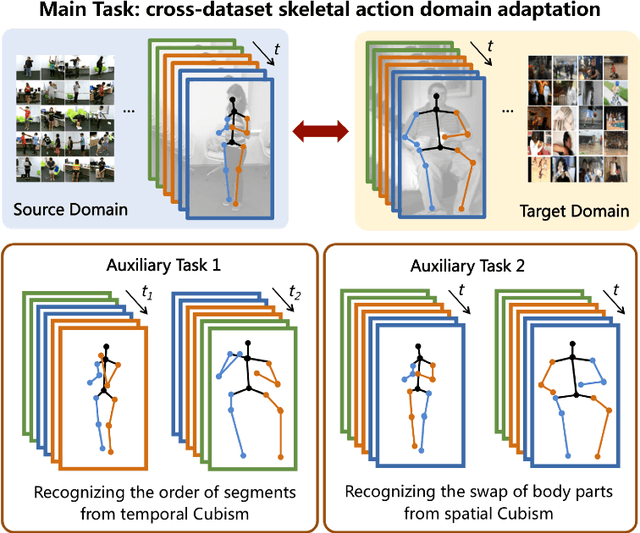
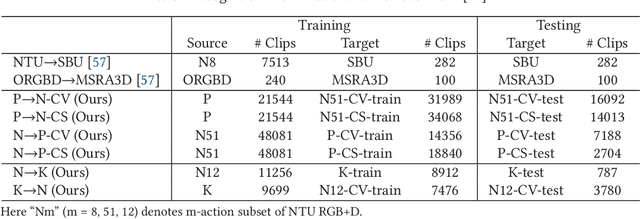

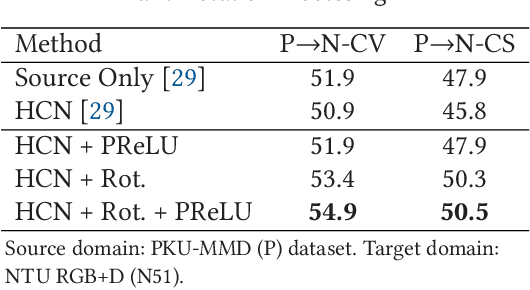
Abstract:Rapid progress and superior performance have been achieved for skeleton-based action recognition recently. In this article, we investigate this problem under a cross-dataset setting, which is a new, pragmatic, and challenging task in real-world scenarios. Following the unsupervised domain adaptation (UDA) paradigm, the action labels are only available on a source dataset, but unavailable on a target dataset in the training stage. Different from the conventional adversarial learning-based approaches for UDA, we utilize a self-supervision scheme to reduce the domain shift between two skeleton-based action datasets. Our inspiration is drawn from Cubism, an art genre from the early 20th century, which breaks and reassembles the objects to convey a greater context. By segmenting and permuting temporal segments or human body parts, we design two self-supervised learning classification tasks to explore the temporal and spatial dependency of a skeleton-based action and improve the generalization ability of the model. We conduct experiments on six datasets for skeleton-based action recognition, including three large-scale datasets (NTU RGB+D, PKU-MMD, and Kinetics) where new cross-dataset settings and benchmarks are established. Extensive results demonstrate that our method outperforms state-of-the-art approaches. The source codes of our model and all the compared methods are available at https://github.com/shanice-l/st-cubism.
* Accepted by ACM TOMM, https://dl.acm.org/doi/10.1145/3472722
SemAffiNet: Semantic-Affine Transformation for Point Cloud Segmentation
May 26, 2022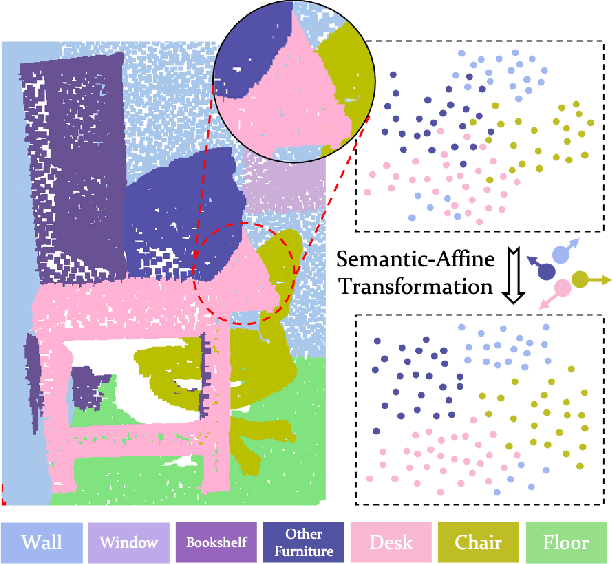
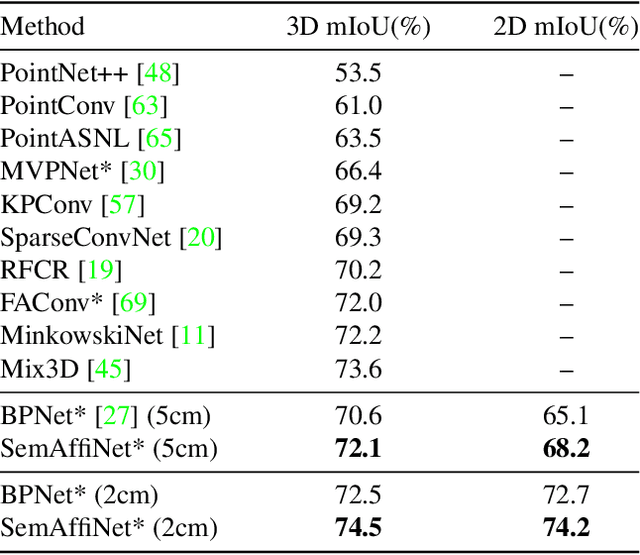
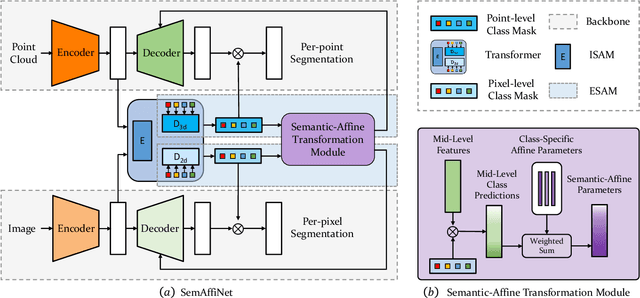
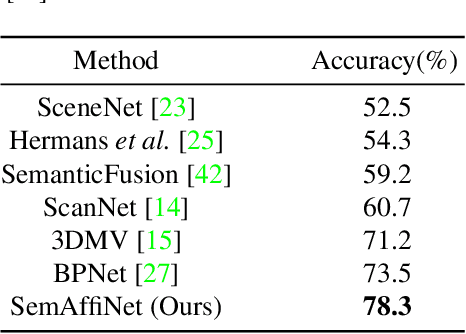
Abstract:Conventional point cloud semantic segmentation methods usually employ an encoder-decoder architecture, where mid-level features are locally aggregated to extract geometric information. However, the over-reliance on these class-agnostic local geometric representations may raise confusion between local parts from different categories that are similar in appearance or spatially adjacent. To address this issue, we argue that mid-level features can be further enhanced with semantic information, and propose semantic-affine transformation that transforms features of mid-level points belonging to different categories with class-specific affine parameters. Based on this technique, we propose SemAffiNet for point cloud semantic segmentation, which utilizes the attention mechanism in the Transformer module to implicitly and explicitly capture global structural knowledge within local parts for overall comprehension of each category. We conduct extensive experiments on the ScanNetV2 and NYUv2 datasets, and evaluate semantic-affine transformation on various 3D point cloud and 2D image segmentation baselines, where both qualitative and quantitative results demonstrate the superiority and generalization ability of our proposed approach. Code is available at https://github.com/wangzy22/SemAffiNet.
FineDiving: A Fine-grained Dataset for Procedure-aware Action Quality Assessment
Apr 07, 2022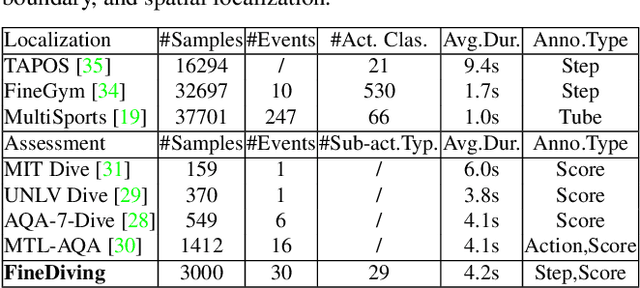
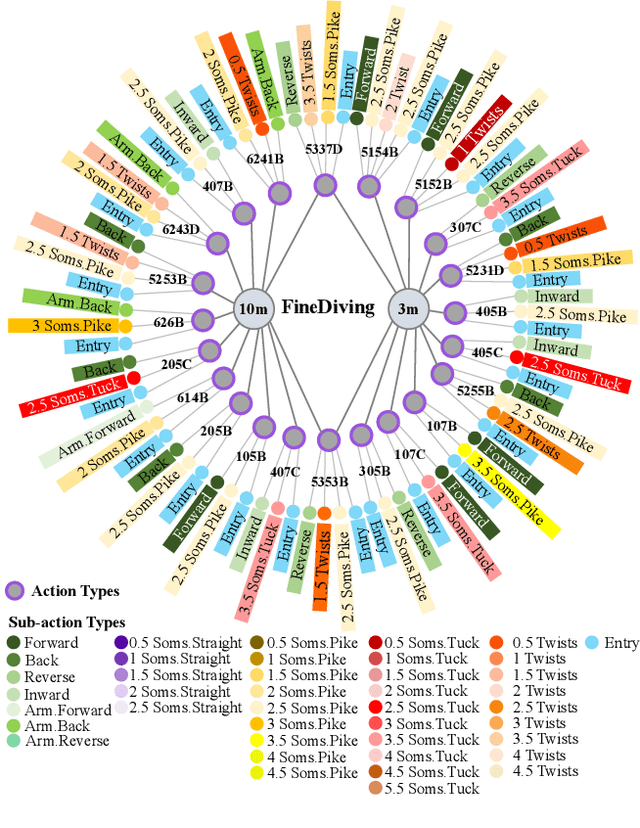
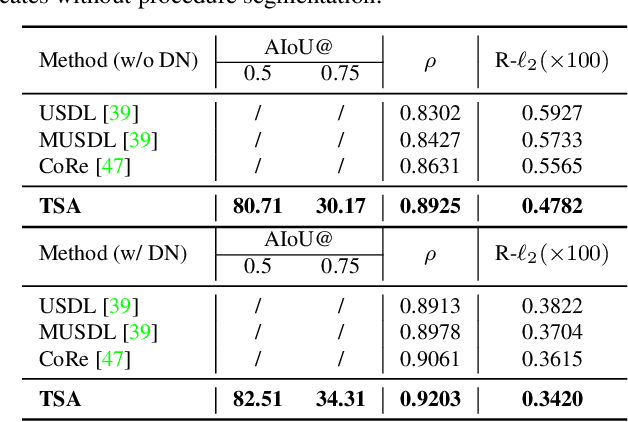
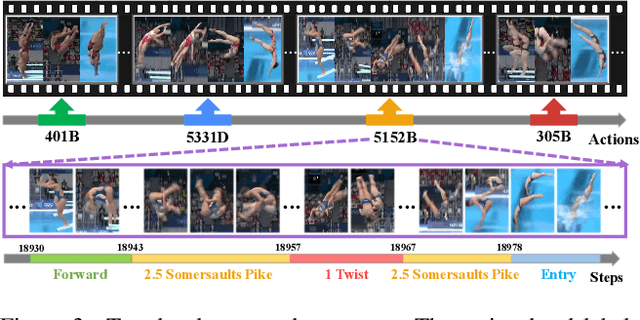
Abstract:Most existing action quality assessment methods rely on the deep features of an entire video to predict the score, which is less reliable due to the non-transparent inference process and poor interpretability. We argue that understanding both high-level semantics and internal temporal structures of actions in competitive sports videos is the key to making predictions accurate and interpretable. Towards this goal, we construct a new fine-grained dataset, called FineDiving, developed on diverse diving events with detailed annotations on action procedures. We also propose a procedure-aware approach for action quality assessment, learned by a new Temporal Segmentation Attention module. Specifically, we propose to parse pairwise query and exemplar action instances into consecutive steps with diverse semantic and temporal correspondences. The procedure-aware cross-attention is proposed to learn embeddings between query and exemplar steps to discover their semantic, spatial, and temporal correspondences, and further serve for fine-grained contrastive regression to derive a reliable scoring mechanism. Extensive experiments demonstrate that our approach achieves substantial improvements over state-of-the-art methods with better interpretability. The dataset and code are available at \url{https://github.com/xujinglin/FineDiving}.
 Add to Chrome
Add to Chrome Add to Firefox
Add to Firefox Add to Edge
Add to Edge